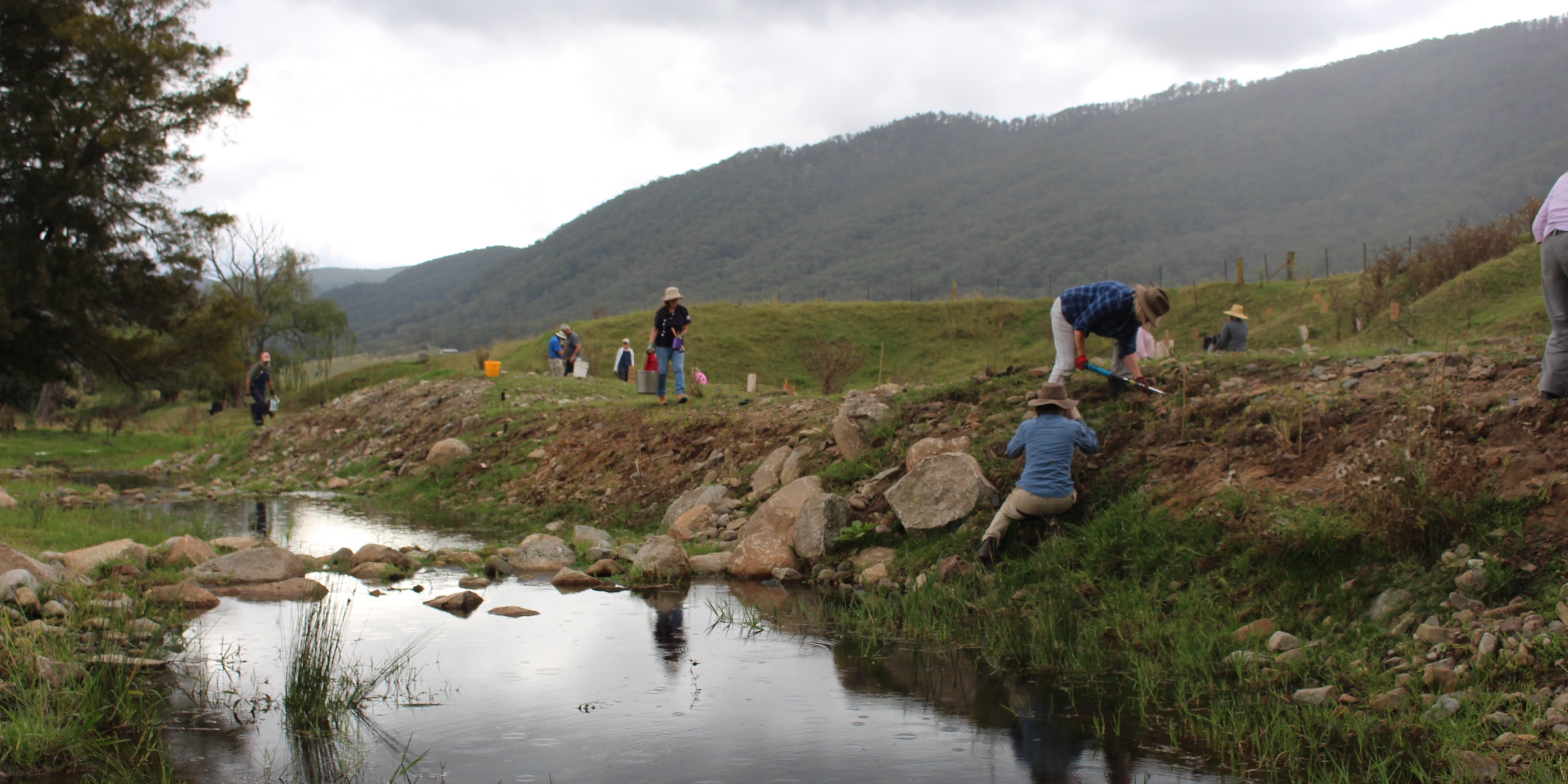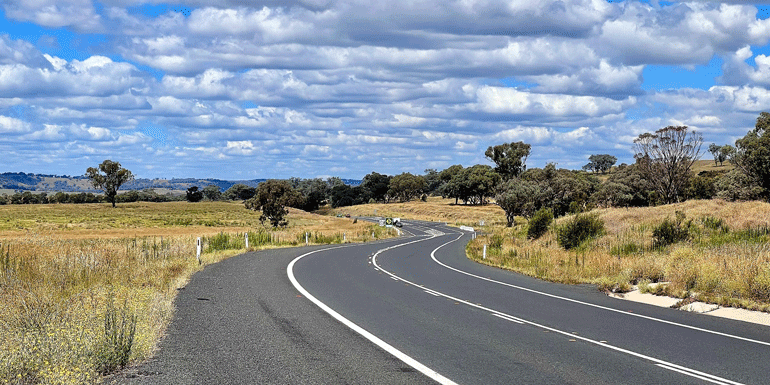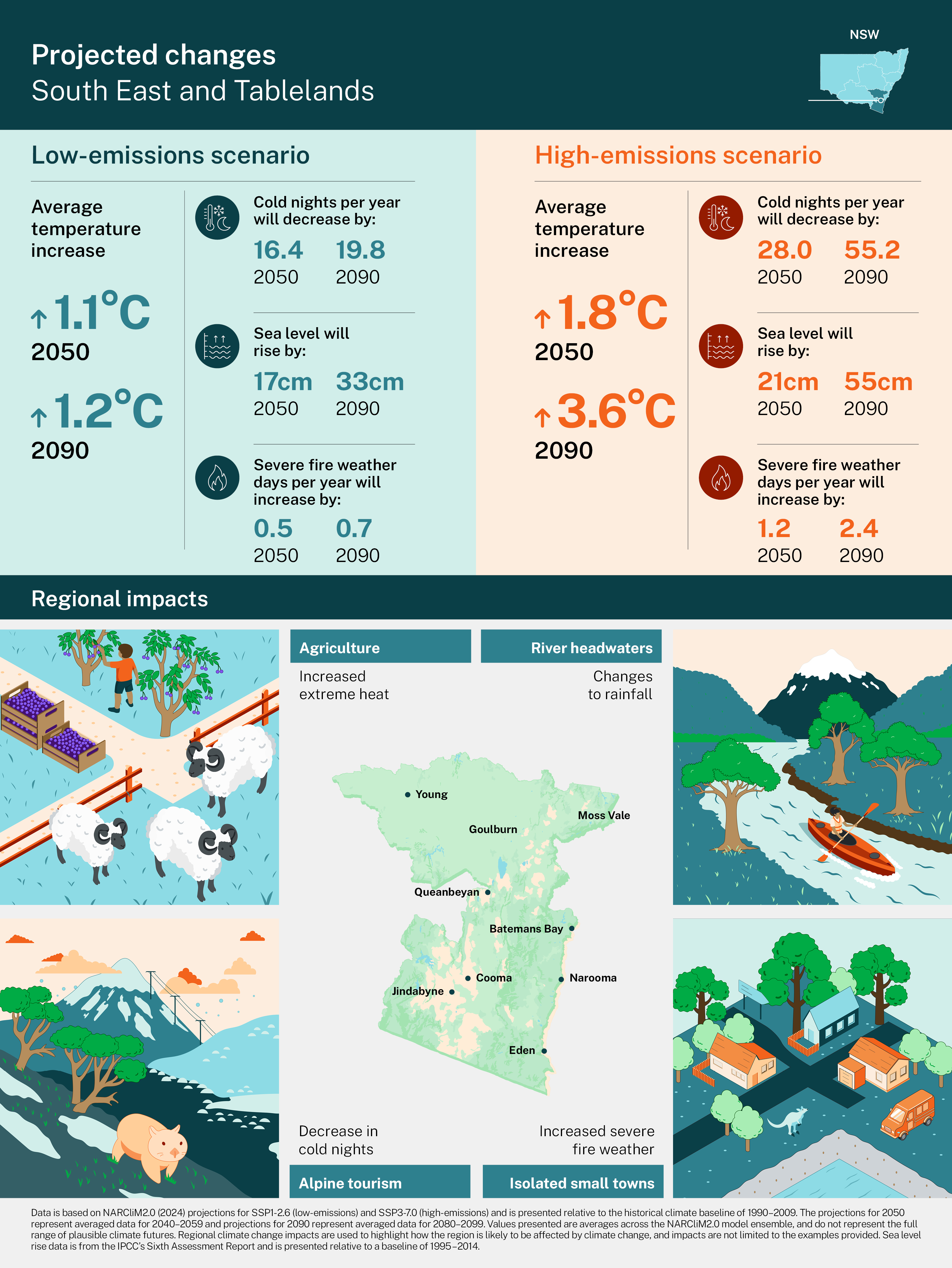Key points
- The South East and Tablelands region contains varied landscapes, with beautiful beaches on the east coast, to the Snowy Mountains inland, and rolling tablelands to the north-west. The region includes a range of industries from agriculture and tourism to public administration around the Canberra region.
- Climate change is affecting the South East and Tablelands, particularly through increased temperatures. Projections show temperatures are expected to keep rising, rainfall patterns will change, there will be more more hot days and heatwaves, and fire weather will increase.
- The NSW Government is helping the South East and Tablelands region adapt to climate change through the Enabling Regional Adaptation work. This is being achieved by working with state and local government stakeholders to identify key aspects of the South East and Tablelands region that are vulnerable to climate impacts, along with challenges and opportunities to adapt.
Importance of the South East and Tablelands region
The South East and Tablelands region is in the south-east corner of NSW, and includes cities, towns and settlements surrounding the Canberra region, including Batemans Bay, Bega, Cooma, Goulburn, Mossvale, Queanbeyan, Yass and Young.
The South East and Tablelands region offers snow, surf and rural living with connections to Canberra and Sydney. The region is known for its beautiful beaches, large coastal embayments, and Australia’s highest summits, including Mount Kosciuszko. It also contains the headwaters of some Australia’s most famous rivers including the, Lachlan, Murray, Murrumbidgee and Snowy.
The highest employing industries in the region include the public sector, hospitality, retail, tourism (skiing and coastal) and agricultural industries including dairy farming and cherry orchards. The region also has a renewable energy industry through the Snowy Hydro Scheme and NSW’s first windfarm, which was established at Crookwell in 1998.
These environmental and economic values are just some aspects of the region which have been identified as being highly vulnerable to climate change. Climate change is already affecting the South East and Tablelands region, particularly through increased temperatures. The impacts of this can be seen through the widespread bushfires of 2019–2020, which burned through many towns and important environmental, agricultural, forestry and tourism areas.
How the South East and Tablelands region is affected by climate change
Key points
The South East and Tablelands is getting warmer
The warmest year on record for both average temperature and maximum temperature in the South East and Tablelands region was 2019, when average temperature was 0.9°C above the 1990–2009 average.
Projected warming
Across the South East and Tablelands, average temperatures will continue to increase throughout this century. By 2090, average temperature is projected to rise by around 1.2 °C under a low emissions scenario and around 3.6°C under a high emissions scenario.
Interpreting the projections
The projections provide a summary of plausible future climate change in the the South East and Tablelands region relative to a baseline of average climate from 1990–2009. Unless otherwise specified, the presentation of data on this page is averaged across a 20-year period from the NARCliM model ensemble. For example, the projections for 2050 represent averaged data for 2040–2059 and projections for 2090 represent averaged data for 2080–2099. In translating the projections, it is important to consider the previous historical changes that occurred prior to 1990-2009. For example, national temperature records indicate that NSW has warmed by 0.84°C between 1910-1930 and the 1990-2009 baseline.
Detailed information on the projected climate changes for the South East and Tablelands region can be found in the South East and Tablelands Climate change snapshot or explored further through the interactive climate projections map.
The annual number of hot days 35°C and above is projected to increase for the South East and Tablelands by 2050. By 2090, under a high emissions scenario, the region is projected to experience nearly 5 times the annual number of hot days, compared with the 1990–2009 average.
Increases are projected to occur across all of the region, with north western areas near Young and Goulburn to experience the largest increases in number of hot days.
The annual number of cold nights below 2°C is projected to decrease for the South East and Tablelands by 2050. By 2090, under a high emissions scenario, the region is projected to experience around 60% fewer annual cold nights, compared with the 1990–2009 average.
Decreases in cold nights are projected to occur across all of the region, with the Snowy Mountains to experience the largest decreases in number of cold nights.
Annual average rainfall in the region is projected to remain variable throughout this century.
On average, the annual number of severe fire weather days is projected to increase for the South East and Tablelands by 2050. By 2090, under a high emissions scenario, the annual number of severe fire weather days is projected to triple for the region.
Increases are projected to occur across the region, with inland areas of the region such as Young to experience the greatest increases.
A sea level rise of 3.7mm/year has already led to increases in inundation of streets in some NSW coastal communities.
Sea level along the South East and Tablelands coast is projected to continue rising under all emissions scenarios. At Eden, sea level is projected to rise by 11–25cm under a low-emissions scenario and by 16–28cm under a high-emissions scenario by 2050. Later in the century, sea-level rise is projected to accelerate under both emissions scenarios, with significantly faster acceleration under a high-emissions scenario. Sea-level rise by 2100 is projected to be 22–57cm under a low-emissions scenario and 51–92cm under a high-emissions scenario.
These projections are relative to a baseline period of 1995–2014. For more detail on the methodology, please access the South East and Tablelands Climate Change Snapshot.
Communities, infrastructure and natural ecosystems are expected to be increasingly vulnerable to the impacts of sea level rise in the future, particularly under a high‑emissions scenario. Find out more about the impacts of sea level rise.
Adapting to changes in the South East and Tablelands region
To help the South East and Tablelands region adapt to the impacts of climate change, more than 150 state and local government stakeholders were brought together in 2014 as part of the NSW Government’s Enabling Regional Adaptation work.
These participants collaboratively identified how different economic, sociocultural and environmental aspects (also known as systems) in the region are vulnerable to climate change. For each of these systems, the vision for a climate-resilient future was identified, and opportunities for action were co-designed.
The Enabling Adaptation in the South East report provides a resource for state and local government and regional communities to understand how climate change will continue to impact the region and our values. It also provides potential opportunities for governments, businesses and communities to adapt to climate change.
The following opportunities for action reflect potential options for state and local government, businesses or community groups to implement. This list has been summarised from the Enabling Adaptation in the South East report. These opportunities provide a starting point for action and will be reviewed and updated to ensure they continue to reflect climate trends, key vulnerabilities and community values.
How we’ve been adapting so far
With the knowledge and partnerships gained through the Enabling Regional Adaptation, there is an opportunity for council, government and communities to show leadership and consider this work in their plans to respond to climate change.
Some opportunities for action are already being addressed by government, community, households and business, to help the South East and Tablelands region adapt to the impacts of climate change and build a sustainable, productive and equitable future.
One example of action being taken is Queanbeyan City Council’s Gross pollutant traps effectiveness project. This project is designed to increase local capacity to treat stormwater runoff from increased rain intensity and storm events, to improve water quality and ecological health in local and neighbouring waterways.
Other examples include the projects supported by the Building Resilience to Climate Change grants and Increasing Resilience to Climate Change grants.
The Enabling Regional Adaptation work has already been used to inform government planning in the South East and Tablelands region, through the South East and Tablelands Regional Plan 2036. Incorporating this work into regional and state plans ensures climate change risks specific to the South East and Tablelands are included.
If you have an example of how a community group, business or local government is adapting to climate change, email AdaptNSW so we can share your story.
Vision
The region has strong regional towns consisting of a mix of enterprises including teleservices hubs, renewable energy, regional tourism, and other lifestyle related business including health business centres.
Opportunities for action
- Improve infrastructure including freight, public transport, renewable energy and telecommunication hubs for regional centres to support the local population and tourism.
- Improve medical services.
- Improve water use and reuse.
- Support young entrepreneurs.
Vision
High-tech telecommuting business hubs diversify the economy and are supported by fast broadband. Community development seeks to attract and retain retirees and enable localised production and events. Towns are able to realise the benefits of adopting local renewable energy generation.
Opportunities for action
- Infrastructure upgrades to telecommunications, freight and public transport matched to demand.
- Change policies to support local and on-farm processing.
- Diversify the economy.
- Offer decision support services for new landholders.
Vision
An educated community is aware of potential hazards and their solutions for coastal development. Owners are protected by rigorous planning regulations for coastal developments, which consider the impacts of extreme weather events. Development is matched to infrastructure, future climate projections and available resources.
Opportunities for action
- Develop innovative water technology and infrastructure.
- Use re-locatable housing, cabins or kit homes and investigate other precinct and legal options to manage residential areas subject to increasing natural hazards.
- Raise people’s awareness and capacity to manage the risk of living with coastal hazards.
Vision
Settlements have local water self-sufficiency. Market mechanisms for water allocation are used where they can increase equity and direct water to highest value uses.
Opportunities
- Adopt enhanced technology and infrastructure to improve water efficiency and reuse, particularly in relation to agricultural storage and use.
- Adopt watersmart town planning and development.
- Engineering of landscapes to improve water functionality.
- Limit water usage through regulation and incentives.
Vision
The region has better integrated health and emergency services that address prevention, preparedness, response and recovery and have well-coordinated surge-capacity response plans. The community is informed and prepared to respond to emergencies, supported by effective engagement and warnings from emergency services.
Opportunities for action
- Build capacity to respond to critical incidents, including more volunteers.
- Improve telecommunication warning tools and information sharing.
- Use development approvals and planning to reduce risk and pre-emptively manage climate impacts.
Vision
The alpine areas (including Thredbo, Perisher, Selwyn and Charlotte's Pass) and the surrounding towns and region become a year-round tourism destination, reducing reliance on winter-based activities. Tourism is developed to conserve and protect the unique features of the area including, climate sensitive endemic species. Tourism is hazard conscious, particularly for fire risk in summer.
Opportunities for action
- Diversify and plan for all season tourism opportunities in gateway towns and across the region, including developing non-snow infrastructure like internationally significant walks and adventure tourism.
- Manage Kosciuszko National Park to support climate change adaptation of sensitive species and ecosystems.
Vision
The region is a year-round destination with eco-sensitive tourism and events that preserve the area's unique characteristics and culture. This is supported by broad marketing, improved transport options and telecommunications infrastructure, and diversified accommodation.
Opportunities for action
- Transition into event tourism in the cooler months, such as to agricultural and food-based tourism.
- Certified and low impact ecotourism activities which align with regional conservation.
- Diversify transport options, to increase access to the area and reaches beyond regional centres.
- Develop coastal tourism packages.
Vision
Public and private land-use management promotes connectivity and is integrated and collaborative across agencies, jurisdictions, Aboriginal and private land holders to enhance and restore habitats. Conservation strategies are integrated into regional planning and development and certified ecotourism operations are functioning by 2050.
Opportunities for action
- Establish and support public–private partnerships and collaboration including conservation based passive tourism.
- Enhance connectivity and consider strategies to enhance species movement and prepare for loss of species or values.
- Develop ex-situ conservation measures, such as seed and DNA banks.
- Build natural resource management and climate adaptation capacity for land managers.
Vision
Adaptive management based on evidence and long-term monitoring is used to manage coastal ecosystems as closed loops to reduce waste impact. Land use is flexible to accommodate species movement with sea level rise. Certified ecotourism is integrated as part of the region’s tourism industry and promotes community awareness and engagement.
Opportunities for action
- Promote ecotourism.
- Research and development to support adaptive management.
- Educate and engage the community through whole of government approaches.
- Support private landholders.
- Establish retreat spaces and facilitate species movement.
- Improve closed-loop management practices.
Vision
Productive rural livelihoods and habitat connectivity are jointly supported through effective natural resource management partnerships. Market mechanisms appropriately value natural resources and ecosystem services.
Opportunities for action
- Use market mechanisms like biobanking to enable the conservation of private land, and development of alternative landscape management models, conservation and agricultural tourism.
- Develop initiatives to increase community engagement and education.
- Improve landscape connectivity and fire management.
Vision
The grazing sector supports financially sustainable livelihoods by consolidating commercial-scale extensive grazing to best-suited lands and diversification of farm income streams. This includes integrating niche agriculture, agritourism, localised food production and renewable energy.
Opportunities for action
- Diversify agribusiness services.
- Protect prime agricultural land through strategic land use planning and tenure.
- Introduce new grazing business models.
- Develop new farm enterprises.
Vision
The Bega Valley and region is a global milk-processing hub, producing a range of products from mass-market to niche and boutique based on sustainable production matched to environmental conditions. Location is a marketing tool and sustainability is increased with improved transportation and a range of business models.
Opportunities for action
- Focus on new business models, improved technology and expanded markets, supported by improved transportation.
- Adopt seasonal dairying practices.
- Source milk from outside the region to complement local production and processing.
Case studies

The Yass Area Network of Landcare Groups is is using the Restore and Renew webtool to guide seed selection for their Climate Ready Revegetation Project.


NSW councils are building climate risk into their business-as-usual planning and policies for the first time, thanks to products developed using NARCliM’s locally relevant climate modelled data.

